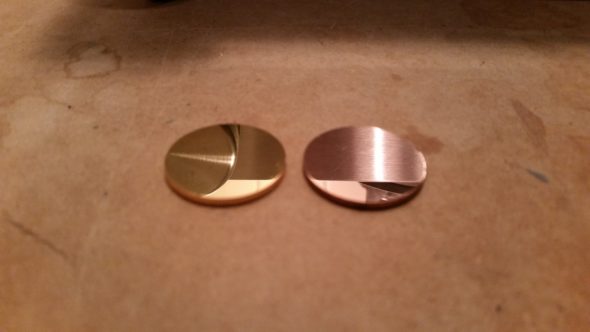
Gold mirrors….. magic?
I have been following Russ Sadler’s series on Youtube for a while now, learning everything I can about my clone laser cutter. I honestly, watched about 3 hours of vids before I even uncrated it to make sure I didn’t mess anything up. In a recent video Russ showed some charts on wavelength reflectivity while trying to achieve maximum output from his laser tube. It seems not all mirrors reflect equally, and the material the mirror is made from makes a large difference in how much power makes it to the cutting board. The stock mirrors aren’t too shabby, but gold and silver mirrors rank higher with silver being the benchmark everything else is measure against. I thought to myself, since I plate silver and gold objects I need to get hold of Russ and see what we can come up with. After a couple emails (Russ is a super nice guy by the way), he sent some copper mirrors for me to plate and send back to him. We talked it over and since silver is susceptible to tarnishing we would try just gold plated mirrors.
Here is one of the copper discs with it’s electrode wire wrapped around it (click any pic to see a larger version if your browser allows it). I chose to go with a circumference contact to try and minimize any distortion on the mirror. Locating the electrode contact point in one area may have lead to a heavier deposit of gold due to a higher ‘charge’ or flow of electrons in a defined area. Stainless wire was used as the electrode since it is specified to be used as the anode in the gold solution.
Here is the disc in a prep bath, the cleaner makes sure the surface is ready to plate. It removes oils, tarnish, and makes the surface more receptive to plating. I limited the amount of time in the solution though to prevent any surface pitting. One again, I needed to be conscious of the surface as a mirror and not to distort it.
The disc is in the gold solution, doesn’t look very gold-like does it? You can see the Stainless anode to the back, plenty of surface area to carry the electroplating charge. Russ sent six disks, or two sets of 3 mirrors. I ran the first batch at 2.5 minutes plating time which is enough to coat the surface but isn’t a thick layer. I ran the second batch at 5 minutes and is the typical plating job I would do for jewelry or decorative objects.
Gold mirror on the left, copper on the right and both highly reflective of visible light. Once again, I tried to put as little gold on the first set to minimize and distortion that might happen, and ran the second set at standard thickness to see if there was any noticeable difference once installed in the machine. Now it’s time to pack them up and send them off to Russ for evaluation. I did not polish the mirrors or apply any treatment to the surfaces. It’s my belief that the anti-tarnish coating in the polish Russ used for the copper mirrors had adverse effects on the reflectivity of those mirrors. The light would have had to pass through that coating twice, once to reach the mirror and once leaving the mirror surface. Any diffraction in the coating would then have a double effect on the light path.
I excitedly await the results. If Russ posts a video on it I will put a link on the blog.



